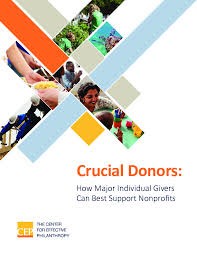- Home
- About Us
- The Team / Contact Us
- Books and Resources
- Privacy Policy
- Nonprofit Employer of Choice Award

 The biggest source of philanthropic support for nonprofits in the United States is giving from individual donors. Of the $428 billion in total charitable giving in 2018, individual donors contributed 68 percent.
The biggest source of philanthropic support for nonprofits in the United States is giving from individual donors. Of the $428 billion in total charitable giving in 2018, individual donors contributed 68 percent.
However, the recent decline in giving among small and medium-gift givers means that major donors are becoming increasingly important to nonprofits.
The Center for Effective Philanthropy (CEP) surveyed its Grantee Voice panel of more than 600 nonprofit leaders across the country to learn what support nonprofits receive from major donors, what major donors can do to support nonprofits better, and how nonprofits’ relationships with major donors differ from their relationships with staffed foundations.
WE LEARNED THAT:
1. Relationships matter. Nonprofit leaders spend more time building personal relationships with major donors as their gifts become larger. In the coming years, the most common trend nonprofit leaders expect to see in how their organizations will work with major donors is that they will place greater focus on building personal relationships with them.
2. There is an understanding gap. To be most helpful, nonprofit leaders believe major donors need to understand their organizations and the context of their work better than they currently do.
3. Nonprofits most need multiyear commitments, unrestricted gifts, and support beyond money. Nonprofit leaders say that these kinds of support help their organizations do their best work and plan for the future.
To read the full report, click here.
The mission of the Center for Effective Philanthropy (CEP) is to provide data and create insight so philanthropic funders can better define, assess, and improve their effectiveness—and, as a result, their intended impact.